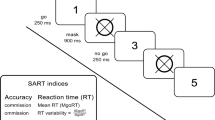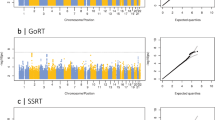Abstract
The ability to inhibit unwanted actions is a heritable executive function that may confer risk to disorders such as attention deficit hyperactivity disorder (ADHD). Converging evidence from pharmacology and cognitive neuroscience suggests that response inhibition is instantiated within frontostriatal circuits of the brain with patterns of activity that are modulated by the catecholamines dopamine and noradrenaline. A total of 405 healthy adult participants performed the stop-signal task, a paradigmatic measure of response inhibition that yields an index of the latency of inhibition, termed the stop-signal reaction time (SSRT). Using this phenotype, we tested for genetic association, performing high-density single-nucleotide polymorphism mapping across the full range of autosomal catecholamine genes. Fifty participants also underwent functional magnetic resonance imaging to establish the impact of associated alleles on brain and behaviour. Allelic variation in polymorphisms of the dopamine transporter gene (SLC6A3: rs37020; rs460000) predicted individual differences in SSRT, after corrections for multiple comparisons. Furthermore, activity in frontal regions (anterior frontal, superior frontal and superior medial gyri) and caudate varied additively with the T-allele of rs37020. The influence of genetic variation in SLC6A3 on the development of frontostriatal inhibition networks may represent a key risk mechanism for disorders of behavioural inhibition.
This is a preview of subscription content, access via your institution
Access options
Subscribe to this journal
Receive 12 print issues and online access
$259.00 per year
only $21.58 per issue
Buy this article
- Purchase on Springer Link
- Instant access to full article PDF
Prices may be subject to local taxes which are calculated during checkout



Similar content being viewed by others
References
Crosbie J, Schachar R . Deficient inhibition as a marker for familial ADHD. Am J Psychiatry 2001; 158: 1884–1890.
Menzies L, Achard S, Chamberlain SR, Fineberg N, Chen CH, del Campo N et al. Neurocognitive endophenotypes of obsessive-compulsive disorder. Brain 2007; 130: 3223–3236.
Hester R, Garavan H . Executive dysfunction in cocaine addiction: evidence for discordant frontal, cingulate, and cerebellar activity. J Neurosci 2004; 24: 11017–11022.
Bellgrove MA, Chambers CD, Vance A, Hall N, Karamitsios M, Bradshaw JL . Lateralized deficit of response inhibition in early-onset schizophrenia. Psychol Med 2006; 36: 495–505.
Schachar RJ, Crosbie J, Barr CL, Ornstein TJ, Kennedy J, Malone M et al. Inhibition of motor responses in siblings concordant and discordant for attention deficit hyperactivity disorder. Am J Psychiatry 2005; 162: 1076–1082.
Friedman NP, Miyake A, Young SE, Defries JC, Corley RP, Hewitt JK . Individual differences in executive functions are almost entirely genetic in origin. J Exp Psychol Gen 2008; 137: 201–225.
Logan GD, Schachar RJ, Tannock R . Impulsivity and inhibitory control. Psychol Sci 1997; 8: 60–64.
Aron AR, Fletcher P, Bullmore ET, Sahakian BJ, Robbins TW . Stop-signal inhibition disrupted by damage to the right inferior frontal gyrus in humans. Nat Neurosci 2003; 6: 115–116.
Aron AR, Poldrack RA . Cortical and subcortical contributions to Stop signal response inhibition: role of the subthalamic nucleus. J Neurosci 2006; 26: 2424–2433.
Garavan H, Ross TJ, Stein EA . Right hemisphere dominance for inhibitory control: an event-related functional MRI study. Proc Natl Acad Sci USA 1999; 96: 8301–8306.
Verbruggen F, Aron AR, Stevens MA, Chambers CD . Theta burst stimulation dissociates attention and action updating in human inferior frontal cortex. Proc Natl Acad Sci USA 2010; 107: 13966–13971.
Chambers CD, Bellgrove MA, Gould IC, English T, Garavan H, McNaught E et al. Dissociable mechanisms of cognitive control in prefrontal and premotor cortex. J Neurophysiol 2007; 98: 3638–3647.
Chambers CD, Bellgrove MA, Stokes MG, Henderson TR, Garavan H, Robertson IH et al. Executive ‘brake failure’ following deactivation of human frontal lobe. J Cogn Neurosci 2006; 18: 444–455.
Chambers CD, Garavan H, Bellgrove MA . Insights into the neural basis of response inhibition from cognitive and clinical neuroscience. Neurosci Biobehav Rev 2009; 33: 631–646.
Bari A, Eagle DM, Mar AC, Robinson ES, Robbins TW . Dissociable effects of noradrenaline, dopamine, and serotonin uptake blockade on stop task performance in rats. Psychopharmacology (Berl) 2009; 205: 273–283.
Nandam LS, Hester R, Wagner J, Cummins TDR, Garner K, Dean AJ et al. Methylphenidate but not atomoxetine or citalopram modulates inhibitory control and response time variability. Biol Psychiatry 2011; 69: 902–904.
Arnsten AF, Dudley AG . Methylphenidate improves prefrontal cortical cognitive function through alpha2 adrenoceptor and dopamine D1 receptor actions: relevance to therapeutic effects in attention deficit hyperactivity disorder. Behav Brain Funct 2005; 1: 2.
Chamberlain SR, Muller U, Blackwell AD, Clark L, Robbins TW, Sahakian BJ . Neurochemical modulation of response inhibition and probabilistic learning in humans. Science 2006; 311: 861–863.
Chamberlain SR, Hampshire A, Muller U, Rubia K, Campo ND, Craig K et al. Atomoxetine modulates right inferior frontal activation during inhibitory control: a pharmacological functional magnetic resonance imaging study. Biol Psychiatry 2009; 65: 550–555.
Congdon E, Lesch KP, Canli T . Analysis of DRD4 and DAT polymorphisms and behavioral inhibition in healthy adults: implications for impulsivity. Am J Med Genet B Neuropsychiatr Genet 2008; 147B: 27–32.
Congdon EE, Figueroa YH, Wang L, Toneva G, Chang E, Kuret J et al. Inhibition of tau polymerization with a cyanine dye in two distinct model systems. J Biol Chem 2009; 284: 20830–20839.
Cornish KM, Manly T, Savage R, Swanson J, Morisano D, Butler N et al. Association of the dopamine transporter (DAT1) 10/10-repeat genotype with ADHD symptoms and response inhibition in a general population sample. Mol Psychiatry 2005; 10: 686–698.
Baehne CG, Ehlis AC, Plichta MM, Conzelmann A, Pauli P, Jacob C et al. Tph2 gene variants modulate response control processes in adult ADHD patients and healthy individuals. Mol Psychiatry 2009; 14: 1032–1039.
Stoltenberg SF, Glass JM, Chermack ST, Flynn HA, Li S, Weston ME et al. Possible association between response inhibition and a variant in the brain-expressed tryptophan hydroxylase-2 gene. Psychiatr Genet 2006; 16: 35–38.
Logan GD . On the ability to inhibit thought and action: a users' guide to the stop signal paradigm. In: Dagenbach D, Carr TH (eds). Inhibitory Processes in Attention, Memory, and Language. Academic Press: San Diego, CA, US, 1994, pp 189–239.
Altshuler D, Brooks LD, Chakravarti A, Collins FS, Daly MJ, Donnelly P . A haplotype map of the human genome. Nature 2005; 437: 1299–1320.
Lowe N, Kirley A, Mullins C, Fitzgerald M, Gill M, Hawi Z . Multiple marker analysis at the promoter region of the DRD4 gene and ADHD: evidence of linkage and association with the SNP 616. Am J Med Genet B Neuropsychiatr Genet 2004; 131B: 33–37.
Kirley A, Lowe N, Hawi Z, Mullins C, Daly G, Waldman I et al. Association of the 480 bp DAT1 allele with methylphenidate response in a sample of Irish children with ADHD. Am J Med Genet B Neuropsychiatr Genet 2003; 121B: 50–54.
Brookes K, Xu X, Chen W, Zhou K, Neale B, Lowe N et al. The analysis of 51 genes in DSM-IV combined type attention deficit hyperactivity disorder: association signals in DRD4, DAT1 and 16 other genes. Mol Psychiatry 2006; 11: 934–953.
Mechelli A, Henson RN, Price CJ, Friston KJ . Comparing event related and epoch analysis in blocked design fMRI. Neuroimage 2003; 18: 806–810.
Nyholt DR . A simple correction for multiple testing for SNPs in linkage disequilibrium with each other. Am J Hum Genet 2004; 74: 765–769.
Cheverud JM . A simple correction for multiple comparisons in interval mapping genome scans. Heredity 2001; 87: 52–58.
Li J, Li L . Adjusting multiple testing in multilocus analyses using the eigenvalues of a correlation matrix. Heredity 2005; 95: 221–227.
Kuntsi J, Wood AC, Rijsdijk F, Johnson KA, Andreou P, Albrecht B et al. Separation of cognitive impairments in attention-deficit/hyperactivity disorder into 2 familial factors. Arch Gen Psychiatry 2010; 67: 1159–1166.
Vaidya CJ, Austin G, Kirkorian G, Ridlehuber HW, Desmond JE, Glover GH et al. Selective effects of methylphenidate in attention deficit hyperactivity disorder: a functional magnetic resonance study. Proc Natl Acad Sci USA 1998; 95: 14494–14499.
Aron AR, Dowson JH, Sahakian BJ, Robbins TW . Methylphenidate improves response inhibition in adults with attention-deficit/hyperactivity disorder. Biol Psychiatry 2003; 54: 1465–1468.
Amara SG, Jonas V, Rosenfeld MG, Ong ES, Evans RM . Alternative RNA processing in calcitonin gene expression generates mRNAs encoding different polypeptide products. Nature 1982; 298: 240–244.
Kozyrev SV, Abelson AK, Wojcik J, Zaghlool A, Linga Reddy MV, Sanchez E et al. Functional variants in the B-cell gene BANK1 are associated with systemic lupus erythematosus. Nat Genet 2008; 40: 211–216.
Bamne MN, Talkowski ME, Chowdari KV, Nimgaonkar VL . Functional analysis of upstream common polymorphisms of the dopamine transporter gene. Schizophr Bull 2010; 36: 977–982.
Feng Y, Wigg KG, Makkar R, Ickowicz A, Pathare T, Tannock R et al. Sequence variation in the 3′-untranslated region of the dopamine transporter gene and attention-deficit hyperactivity disorder (ADHD). Am J Med Genet B Neuropsychiatr Genet 2005; 139B: 1–6.
Ouellet-Morin I, Wigg KG, Feng Y, Dionne G, Robaey P, Brendgen M et al. Association of the dopamine transporter gene and ADHD symptoms in a Canadian population-based sample of same-age twins. Am J Med Genet B Neuropsychiatr Genet 2008; 147B: 1442–1449.
Watanabe T, Fujiwara T, Komazaki S, Yamaguchi K, Tajima O, Akagawa K . HPC-1/Syntaxin 1A suppresses exocytosis of PC12 cells. J Biochem 1999; 125: 685–689.
Acknowledgements
This work was supported by grants from the Australian Research Council (DP0770337) to MAB and CDC, and from the Australian National Health and Medical Research Council (APP1006573) to MAB, RH, ZH, HG and CDC. MAB and RH are supported by Career Development Awards from the NHMRC Australia. We thank Melany Christofidis and Elliot Lambert for assistance with data collection and Misha Byrne for assistance with preparation of figures.
Author information
Authors and Affiliations
Corresponding author
Ethics declarations
Competing interests
MAB has received reimbursement from Lilly Pharmaceuticals for conference travel expenses and for speaking at conferences. MAB has received speaker's fees from Jannsen Cilag and Lilly Pharmaceuticals. The remaining authors declare no conflicts of interest.
Additional information
Supplementary Information accompanies the paper on the Molecular Psychiatry website
Supplementary information
Rights and permissions
About this article
Cite this article
Cummins, T., Hawi, Z., Hocking, J. et al. Dopamine transporter genotype predicts behavioural and neural measures of response inhibition. Mol Psychiatry 17, 1086–1092 (2012). https://doi.org/10.1038/mp.2011.104
Received:
Revised:
Accepted:
Published:
Issue Date:
DOI: https://doi.org/10.1038/mp.2011.104
Keywords
This article is cited by
-
Genotype-by-diagnosis interaction influences self-control in human cocaine addiction
Translational Psychiatry (2023)
-
Symptom-guided multimodal neuroimage fusion patterns in children with attention-deficit/hyperactivity disorder and its potential “brain structure–function-cognition–behavior” pathological pathways
European Child & Adolescent Psychiatry (2023)
-
Working memory and reaction time variability mediate the relationship between polygenic risk and ADHD traits in a general population sample
Molecular Psychiatry (2022)
-
Effects of the dopamine transporter gene on neuroimaging findings in different attention deficit hyperactivity disorder presentations
Brain Imaging and Behavior (2021)
-
Neuroimaging Risk Markers for Substance Abuse: Recent Findings on Inhibitory Control and Reward System Functioning
Current Addiction Reports (2015)



